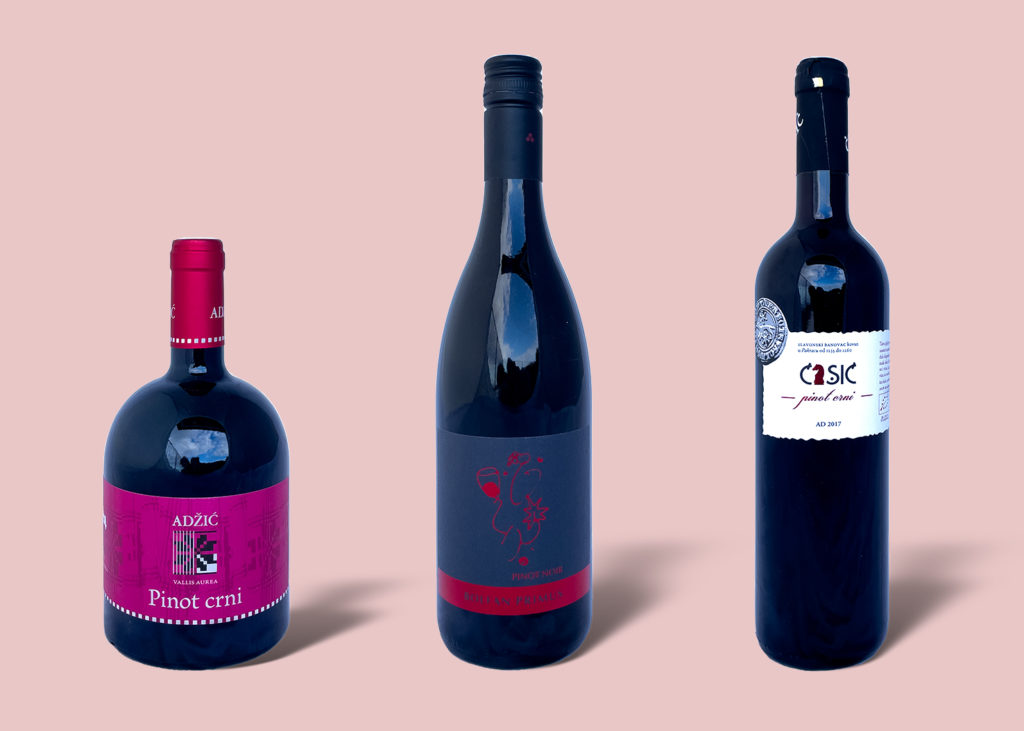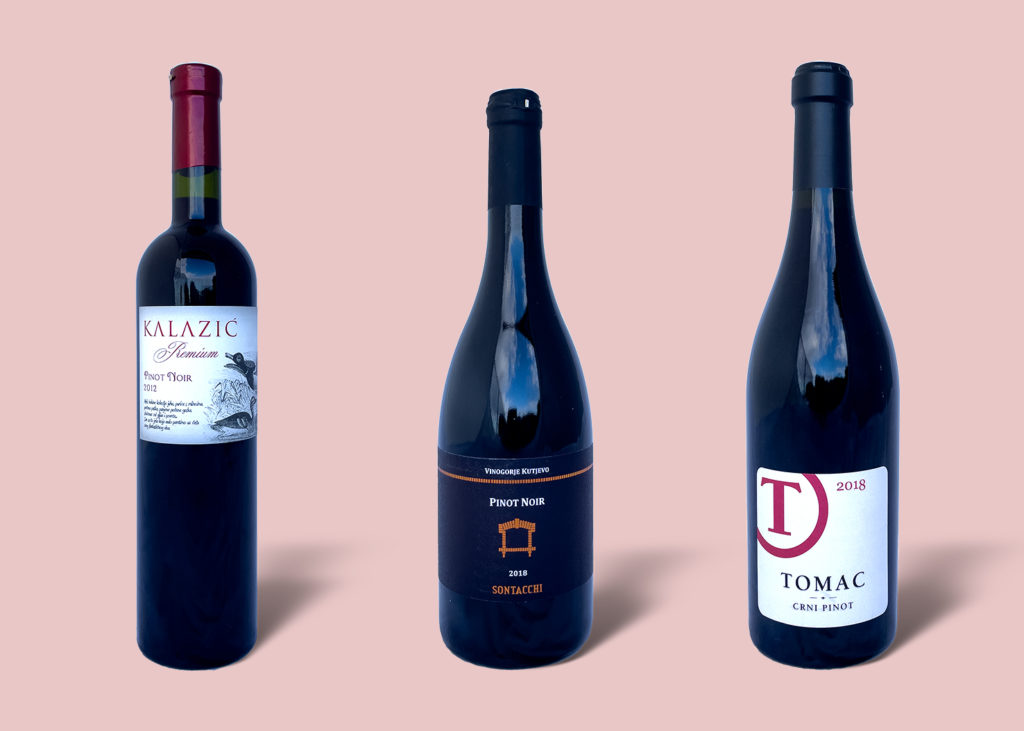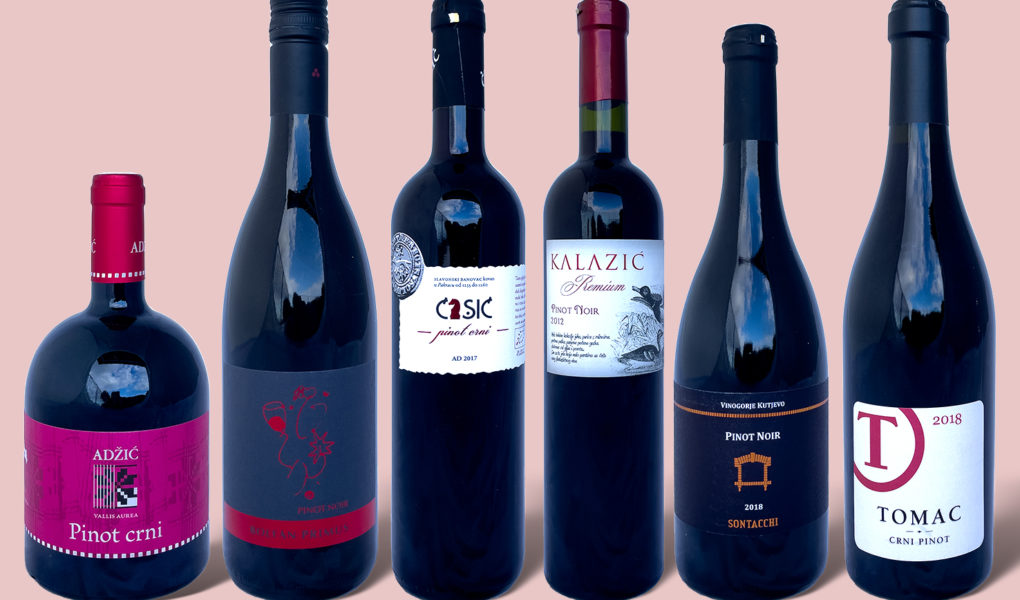Pinot Noir is a light, elegant red wine that is familiar to most everyone. It is an easy choice for its generally lower alcohol and its versatility with food. We tasted six Croatian Pinot Noirs from five wine subregions, and found two basic styles.
The first has earthy flavors and is ready to drink now; some even had the barest meaty or mushroomy notes, which red wine develops as it ages. These wines were slightly older vintages than the others, and were perhaps given more oxygen contact during winemaking. The second style is big, fruitier, with more tannin. These wines can be drunk now, but it seems they are made to be aged. After a few years the tannins will be less chewy, the fruit will mellow and more complex flavors will emerge. We chose a favorite from each style.
Pinot Noir is not native to Croatia, but there are plenty of cool growing areas on the eastern side of the coastal mountain range that are well suited to it. The first region that comes to mind is Plešivica, west of Zagreb. Here, Pinot is used both for earthy reds and for the sparkling wines the region is famed for. But Pinot grows in the cool, hilly regions all around Zagreb. And wine makers in Slavonia produce gorgeous Pinots from their rolling hillsides, particularly around Kutjevo.
Indeed, it seems that much of the Pinot Noir made in Croatia is high in quality. One likely reason for this is that wine makers don’t grow Pinot by accident. They’ve made a commitment to a finicky grape, one that requires special dedication and diligence. Another reason is the number of excellent precedents that exist–from Burgundy to northern Italy to Sonoma–to set a high standard for Croatia’s Pinot Noirs. Croatia’s wine makers have accepted the challenge.
The Tasting
Note: This tasting is meant to be readable, not comprehensive. We tasted six wines, not 60. The wines are listed in alphabetical order by producer. A star (*) indicates wines that stood out for their quality and flavor on the day of the tasting.
The wines for this tasting were kindly provided by Wine & More, and the prices listed are those at their webshop.

*Adžić Pinot Crni 2016 (Kutjevo) 145 kn / €19
Our favorite from the first, earthier style of Pinot, the Adžić offers intensely Pinot aromas of cherries, both tart red ones and brandied. Another Pinot trademark: zesty acidity, which pops out like a beacon against the smooth tannins and lighter body of this wine. With flavors of dried cherries, a touch of clove and a grilled meat note we’re partial to, this wine has plenty to hold our interest–and the finish goes on and on.
Bolfan Primus Pinot Noir 2017 (Zagorje-Međimurje) 153 kn / €20
The Bolfan Pinot has friendly, fresh floral aromas, plus red apple. It’s when you taste it that you realize what a big, serious wine this is. The tannins are more noticeable, and the alcohol is a bit over the top, at 14.5%. Still, the flavors of cherries, pomegranate and black tea hold something in promise for five to eight years from now. For now, guest tasters said it was “strong,” and “I would prefer this when I eat something.” Organic
Ćasić Pinot Crni 2017 (Slavonija) 76 kn / €10
The least expensive of the group, and also the most accessible. This has a softer, delicate aroma of flowers and fresh apple, like a pretty spring perfume. The fruitiness carries through when you taste it, in pleasant red cherry flavors along with autumn leaves. The tannins are easygoing, and it has a noticeable vanilla aroma from the oak aging. Friendly on its own and plays nicely with food–a good all-arounder. Organic

Kalazić Premium Pinot Noir 2012 (Baranja) 95 kn / €12.49
The oldest wine in our lineup, this shows some of the less-expected aromas and flavors that develop in the bottle over time. The cherry aromas tipped toward candied fruit, almost watermelon. There was a distinct floral note like violet and a slight vegetal aroma like overripe melon or butternut squash. After the bottle was open for a while we detected mushrooms as well. Amazingly, all of these are pretty normal. Equally nice for solo sipping or dinner, with a long, forest-scented finish.
Sontacchi Pinot Noir 2018 (Kutjevo) 99 kn / €13
“Drinkable, really smooth,” commented our guest tasters, who liked the fruity cherry notes. This is the subtlest of the wines in the big/fruity category. It still has a hearty structure of acidity and tannin, but the flavors are less revealing. The wine seemed a bit closed, but for guest tasters, simpler was better. They pronounced the Sontacchi “easier to drink,” with or without food.
*Tomac Crni Pinot 2018 (Plešivica) 153 kn / €20
Make no mistake, this Pinot is still young. Right now, it needs food–duck, or polenta topped with Taleggio and mushrooms would be just right to take the edge off its acidity and tannin. That’s rewarding enough, but wait five to eight years and its cherry aromas with a light lactic note and its long, delicate fruit finish will evolve into something magnificently sippable. It’s the best of both worlds: get a few to open and a few to save. Biodynamic
Cheers Croatia Magazine conducts wine tastings in the semi-blind format. This means that we know what wines we have, but they are placed in numbered bags so we can’t identify them during the tasting. Wines for tastings are purchased, or occasionally donated by the winery. See the magazine’s Affiliations and Gifts Policy for more information.

